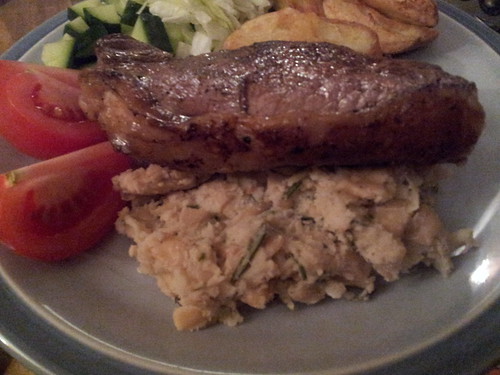Another insanely easy, quick mid week dinner for you. This recipe comes from Donna Hay’s Fast, Fresh, Simple, via the Good Food Channel.
You may have noticed that I am a huge fan of cannellini beans. Indeed, I’m a big fan of beans in general and I’d urge everyone to have a good collection of tinned beans in their cupboards. They’re cheap, nutritious and can solve a variety of food related problems.
Anyway, while Andy was dealing with the barbecue and two generous porterhouse steaks (that’s sirloin if you’re reading from the UK) I was opening the tin of cannellini beans.
ALWAYS rinse (and drain) the beans when they come out of the tin. Firstly, they always smell horrible and secondly, often tinned things are very salty and a good rinse helps to reduce that.
In a small saucepan I had some olive oil heating up into which I put a some crushed, minced garlic and some finely chopped fresh rosemary. In went the beans to heat through along with a good squeeze of lemon juice.
At this point I decided to mash the beans coarsely with the back of a fork. This, I think, was a mistake. It would have been much nicer to have the beans whole.
I thought the mixture tasted good and was really tempted not to add the horseradish. Andy tasted it and thought it needed the horseradish, otherwise it was just like “that dip you make“. I think the horseradish is really up to you – you may prefer to serve it on the side so you can slather your beef in it.
Of course, steak and a few beans does not a whole meal make. We served with salad and some roasted potato wedges.
Another big win for meal planning and quick, easy, midweek dinners.



